From the October 2025 issue of Apollo. Preview and subscribe here.
When the Princeton University Art Museum reopens at the end of the month at the heart of a historic campus older than the United States, it will have been five years in the making and even longer in the planning. Its new home, a 13,500-square-metre modernist statement piece designed by Adjaye Associates, unites a collection that spans world cultures and time periods, defined by the interests of generations of alumni and an acquisitions budget beyond the dreams of most universities. Among its ambitious opening displays is a series of six contemporary art installations that have been commissioned or acquired for the building’s inauguration by Nick Cave, Diana Al-Hadid, Jane Irish, Tuan Andrew Nguyen, Jun Kaneko and Rose B. Simpson.
In many ways the project is the culmination of nearly 275 years of collecting and a series of expansions over the centuries. The university received its first art donation, a portrait of colonial New Jersey’s governor Jonathan Belcher, just before it moved to its current site in the town of Princeton in 1756. Donations from alumni have expanded its collection over the years: an especially large bequest came in 1944, comprising thousands of works amassed by the collector and archaeologist Dan Fellows Platt (class of 1895) and donated by his widow, the tennis champion Ethel Bliss Platt. This included antique Italian furniture, albums of drawings and barrels full of Renaissance paintings and antiquities. Strategic acquisitions have been enabled by an endowment established in the late 19th century by Allan Marquand (class of 1874), the university’s first lecturer in art history and the museum’s first director. Although the museum does not disclose the endowment’s exact worth today, it can chase works when they come on to the market, even those that carry a six or seven-figure price tag, such as a rare impression of Rembrandt’s etching The Three Trees, which the museum acquired in 2019; another example sold at auction for £869,400 in 2023.
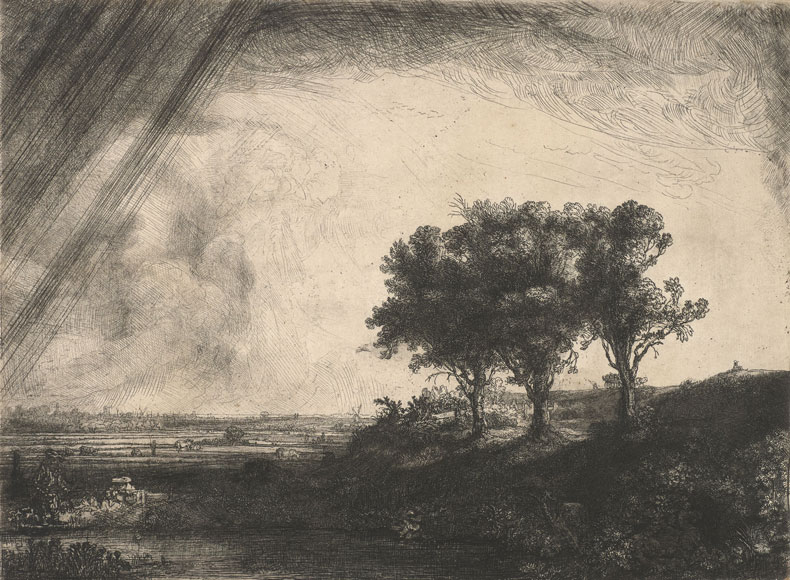
Today, Princeton’s collection ranges across painting, antiquities, ceramics, prints and drawings, illuminated manuscripts and more. A particular highlight are the 22 sculptures by modernist masters including Alexander Calder, Henry Moore, Louise Nevelson, Isamu Noguchi and David Smith, installed across the campus. But finding a space to display the rest of its holdings properly has proved tricky.
The first concerted effort to build a museum was undertaken in 1882 – when Princeton decided to establish an art history department – and a new three-storey building, designed by A. Page Brown in Romanesque Revival style, was completed in 1890. Members of the public could visit the museum’s collections by asking the janitor for a key. The first expansion was built in 1923, in a Venetian Gothic style, by campus architect Ralph Adams Cram, who was also responsible for the university’s chapel and Graduate College, and another addition made in 1935. But most of the older structures were demolished to make way for a larger building in the International Style, designed by the New York firm of Steinmann and Cain and completed in 1966. Another extension was added in 1989, designed by the New York firm Mitchell Giurgola. The result was a museum that had been ‘cobbled together over the years’, its galleries ‘awkwardly configured’, leaving the institution ‘in dire need of more space’, a university working group reported in 2016.
The new building, which takes up roughly the same footprint but provides double the space for displays and education, aims to solve those problems. But when David Adjaye unveiled his design in 2020, making clear that its nine hovering ‘pavilions’, cantilevered above pedestrian level, would not echo the campus’s Gothic style, reactions from students and alumni were mixed. Controversy was stoked further when, in 2023, several of Adjaye’s former employees alleged that the architect had sexually harassed them. (After Adjaye stepped back from a number of projects, final construction at Princeton was overseen by executive architect Cooper Robertson.) As the new building came together, with its aggregated stone curtain walls, mass timber and bronze panels, some alumni compared it to an Amazon warehouse or a monolith dropped on to campus by aliens.
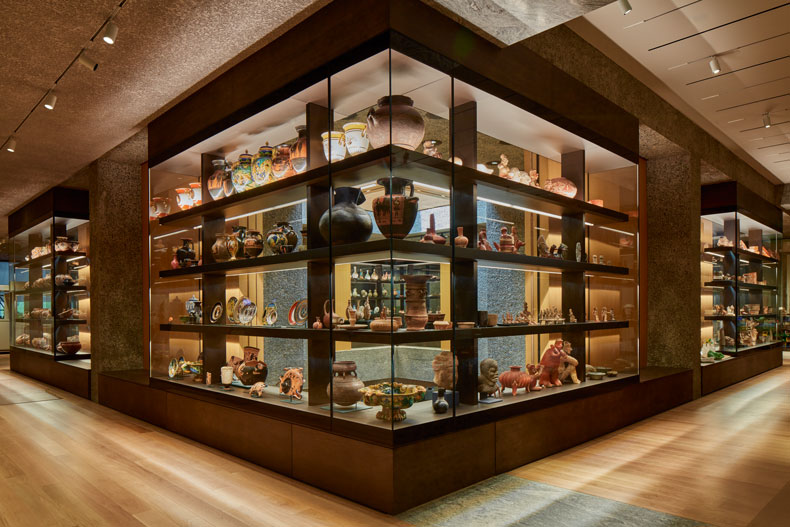
‘I feel very strongly that this [campus] is a national resource,’ says W. Barksdale Maynard (class of 1988), a lecturer in art and architectural history and author of a book on Princeton’s history. ‘This campus is so old, so historic, so little changed. People come here and they’re charmed by it, because it is old-fashioned and it is quaint. I think when you insert these mega-structures into that context, you do great damage.’ Maynard suggests that such a building might have been more fitting on the edge of campus, near the Lewis Center for the Arts and the university train station, or even on the other side of nearby Lake Carnegie, where the university has sports pitches.
As the opening nears, others have called for the Princeton community to give the building a chance. The artist and sculptor David Chamberlain (class of 1971) thinks that having an art museum at the centre of the campus matters for a university known for its liberal arts curriculum. ‘To have the history of art and the completed, finished works sharing the same places and the same conversations and the same critical thinking process, I think that’s really important academically,’ he says. Once the shock of change has worn off, Chamberlain sees the new museum being recognised as a benefit for students and locals. ‘I think for the first year, it’s going to remain controversial, but it’s going to grow on people very quickly. I bet five years from now, it’ll become one of the favourite buildings on campus to work in, as well as to visit.’
Kayleen Gowers (class of 2025), the founder of the university’s Architecture Club and now a designer at Studio Hillier, a local architecture and design firm, says that the new museum was a big topic of conversation among her classmates, along with other construction projects taking place across the campus. (The university has been on a building spree in recent years to accommodate a growing student population.) While the design was not an immediate favourite among students, she sees it as a bold choice that emphasises how much the university engages with the present. ‘If Princeton only preserved its past, it would risk becoming a museum of itself,’ Gowers says. She is keen to see the museum become a place where the university and the town can meet: ‘That kind of overlap creates community.’
The desire to attract this dual audience was the reason to keep the site where it is, within a 10-minute walk of every undergraduate residence hall and close to the town’s main thoroughfare on Nassau Street, according to James Steward, director of the museum since 2009. ‘Symbolically, it’s both incredibly important and rare that a university like Princeton, when it came time to make a better art museum building, would make the decision to do it right in the middle of the campus, a stone’s throw from the historic centre, because the more commonplace decision would be to find some unbuilt edge location,’ he says. ‘Students would not, in fact, be able to stop in, in the two minutes they have between their residences and the dining hall.’
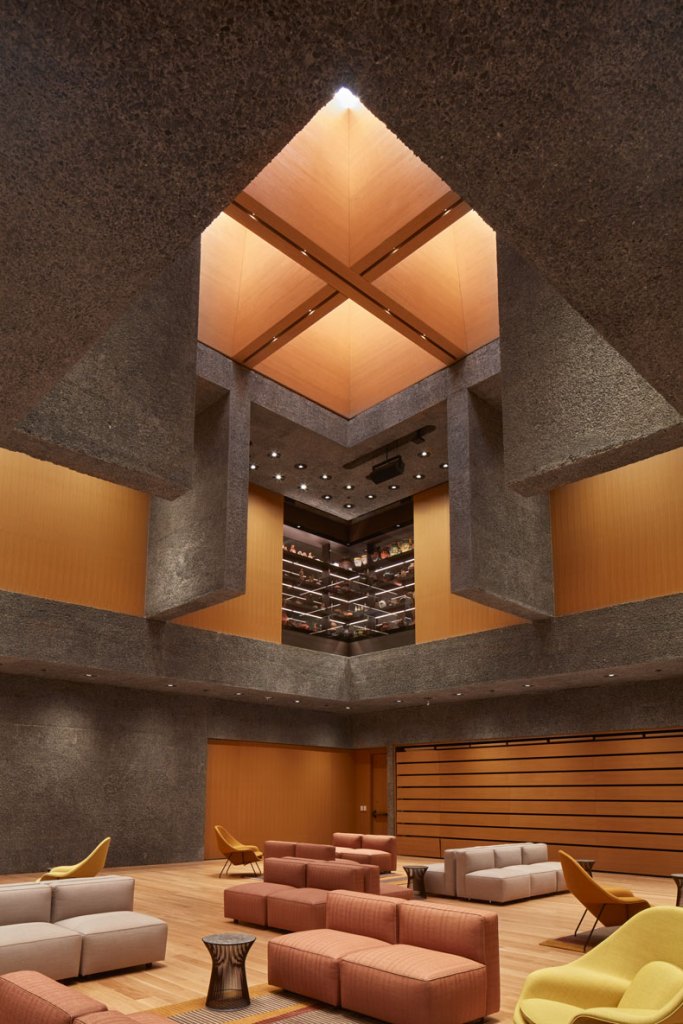
Ease of access also guides the layout of the museum, with entrances on all four sides – a rarity among new museum buildings, Steward says. The pedestrian arteries that students use to traverse the campus continue through the building in ‘art walks’ that intersect the structure, with works from the collection installed along these routes.
The northern entrance, for example, features a glittering, six-metre-tall wrap-around mosaic mural by the multimedia artist Nick Cave, in which one of his Soundsuited figures welcomes visitors with a bow. The dark wooden elements in the piece come from elm trees that were cut down to make way for the new museum. It is one of the four new commissions, continuing the tradition of public art on campus, and Cave’s largest work of art to date.
Meanwhile, those that enter from the south walk over a stunning third-century mosaic pavement depicting a drinking contest between Heracles and Dionysus, one of a series of antiquities excavated from ancient Antioch, in modern-day Turkey, by Princeton archaeological teams in the 1930s. Several of these have been installed in the museum floors, underneath heavy protective glass, so visitors experience them in almost the same way their Roman owners would.
If liveable interiors are the true test of a building, then the new museum should pass with honours. The Grand Hall atrium, with concrete buttresses suspended impressively above visitors’ heads, is full of comfy sofas and area rugs. But it also doubles as a classroom or event space, with bleachers that accommodate 265 people hidden inside one wall and a sunken stage and projection screen against the other. Glimpses of the museum’s collection on the second floor, specifically art of the ancient Americas, can be seen from the display cases embedded in the upper walls. ‘Once you enter the building, you experience the invitation to linger, to participate in a programme, to explore the galleries,’ Steward says.
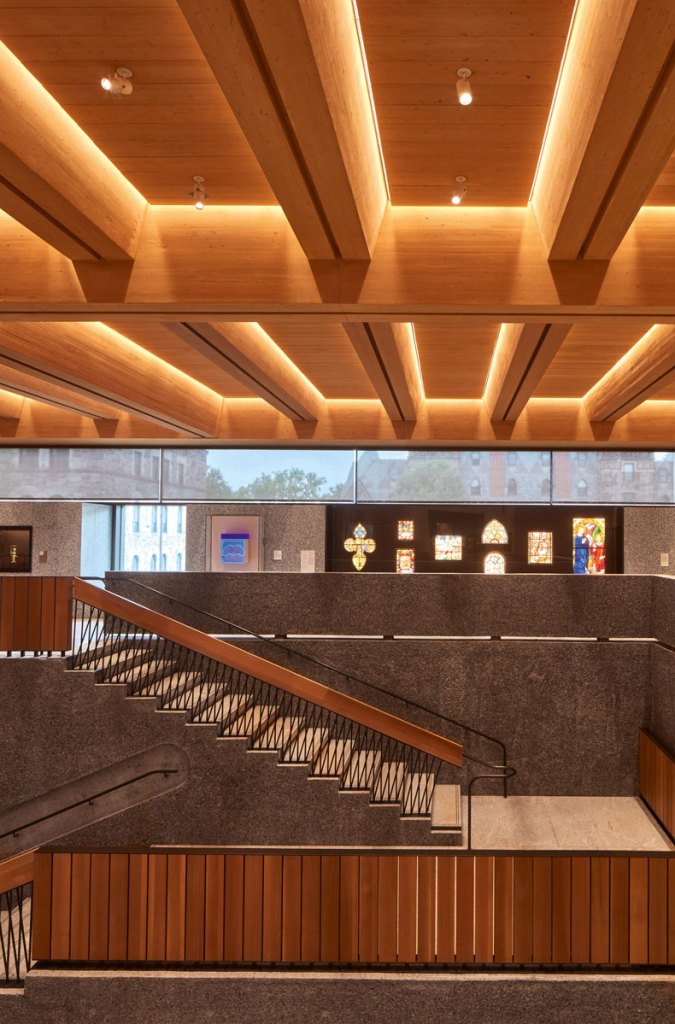
While most of the ground floor is taken up by study rooms, for instance, pieces of the collection can be found in all corners, including a wall of curated objects along a row of lockers and a 16th-century Mallorcan stone staircase hanging next to the actual stairs that lead to the collection galleries, restaurant and terrace on the floors above. These central public spaces, including a vitrine-filled ‘orientation gallery’ on the upper landing, will remain open for extended hours every day of the week. ‘If we want everyone to truly think of this as their museum, we have to, in some part, meet them where they are and not expect them to adapt to us,’ says Steward. Even the collection galleries will remain partially visible after hours through bronze chain-mail grilles, encouraging repeat visits.
The appeal to visitors to make their own discoveries continues throughout the galleries on the second floor, in which more of the 117,000-piece collection is on view than ever before, including some ‘dense display’ vitrines that serve as a middle ground between more selective curation and open storage. Because of the museum’s generous acquisitions endowment, as well as more than 2,000 recent donations made during the construction process, many of the objects are on view for the first time. ‘We’re not a museum that regards its collections galleries as static or permanent,’ Steward says. ‘I have tried to ban the use of the word “permanent” because I think it creates a false understanding of what a collection is, especially in a college environment. You should understand the collection as this living, ever-evolving thing.’
Following this direction, the curatorial team has installed works more loosely across the galleries, sometimes grouping things chronologically, sometimes thematically, and allowing for artistic interventions. A thorny table and chair by Hugh Hayden sits next to colonial American furniture and paintings, for example. Elsewhere, a large black and orange Roberto Lugo vase, painted with urban street scenes, stands alongside ancient Mediterranean art. On the ground floor, a gallery opens with a presentation centred on the experimental ceramicist Toshiko Takaezu, who taught at Princeton for more than 25 years, which includes works by her teachers and students. It also places Takaezu’s art in the context of abstract artists working at the same time, such as Helen Frankenthaler and Isamu Noguchi.
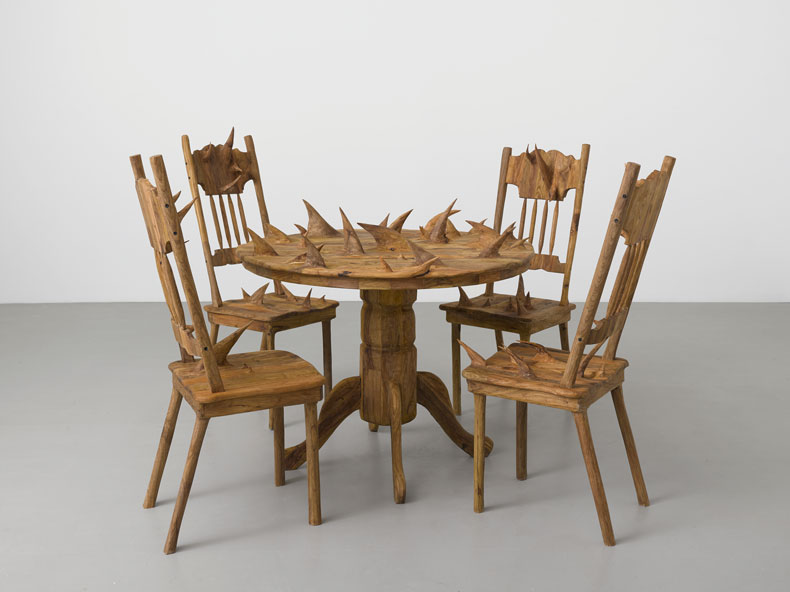
The diversity of the museum’s collection and its egalitarian approach to works from different cultures and time periods is also due to its relatively secure position as a private, well-funded university. While the Trump administration is trying to dictate how American institutions interpret history and culture, targeting elite universities including Princeton, Harvard and Columbia, it has done this mostly by freezing access to federal grant money and raising taxes on the income these universities draw from their endowments. Unlike the leadership at other schools, which have sought conciliatory settlements with the White House, Princeton’s president, Christopher L. Eisgruber, has asserted the university’s independence.
The university itself has a healthy endowment of $34.1 billion (the fifth largest in the country) and 60 per cent of the museum’s $30 million operating budget comes from endowment funds. Practically, this means that the museum’s primary operations are somewhat sheltered, but it cannot rely on receiving federal funding, such as a National Endowment for the Arts grant, to support things like temporary exhibitions. ‘It’s a reminder that curation is a privilege, not a right, and can really be an incredible expression of freedom,’ says Juliana Ochs Dweck, the museum’s chief curator.
Steward says that the museum is actively thinking about how much of a risk it can take in the current environment, and in what form. ‘I do think we can be very head-on about questions like, “How does art make us better citizens of the world, and therefore what are some of our responsibilities as a cultural institution in shaping dialogue?”’ he says. ‘My goal would be to do so in a way that allows as many people to come to the table as possible. In other words, I don’t want to be so “partisan” that 40 per cent of the American public doesn’t want to come through our doors because they don’t think we’re a place for them.’
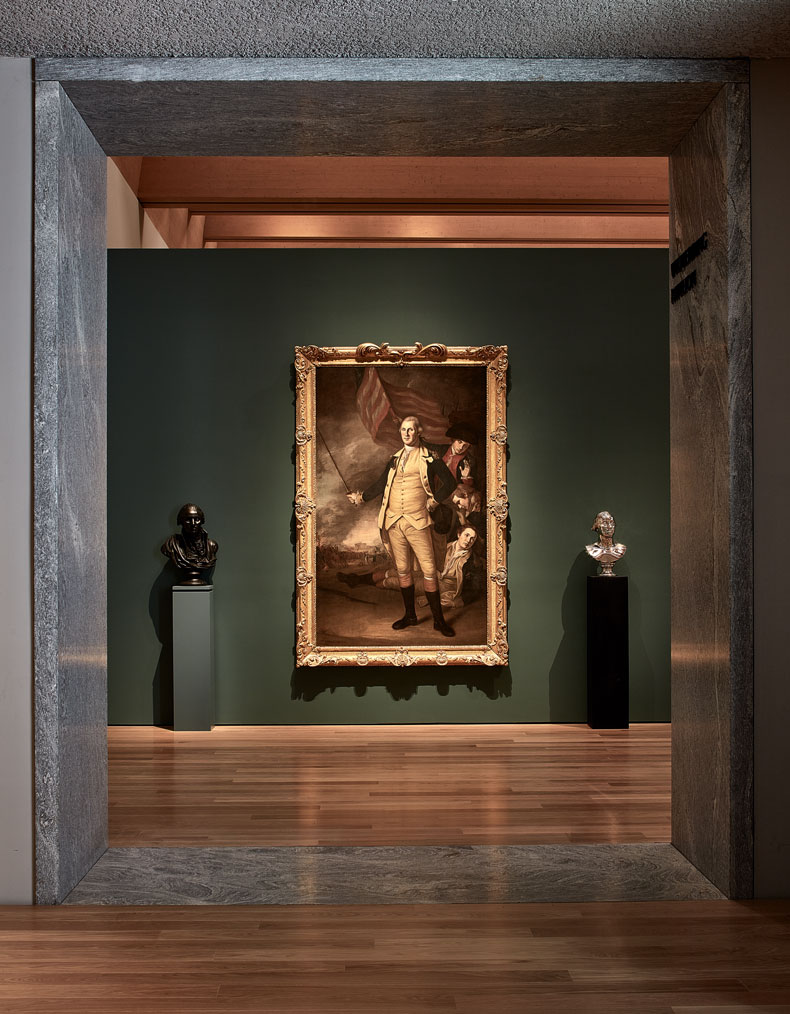
Fans of ancient Roman sculpture, for instance, are as likely to find a worthwhile experience in the galleries as those interested in modern painting. ‘The visitor has, in some sense, more autonomy and agency in this new building than they did in the old one,’ Dweck says. ‘They really need to make decisions as to what their pathway is, how they want to experience [the museum], what galleries they want to see, what style, what they want their pace to be.’
Open sight lines allow recognisable works, such as Charles Willson Peale’s portrait of a victorious George Washington (1784) – the frame of which, according to legend, once held a portrait of George II ‘decapitated’ by a cannonball during the Revolutionary War – to serve as visual anchors. These direct visitors to different parts of the collection. There are nooks and niches throughout the building, some containing displays such as an ingeniously concave shelf of miniature objects in the Asian galleries, or a relaxing viewing room off the modern and contemporary art collection featuring a new commission by the Philadelphia-based artist Jane Irish installed in the ceiling. From almost every room, rectangular and circular windows frame views of the Princeton campus. In this way, the university’s historic architecture and arboretum-like landscape become another part of the collection to admire and absorb.
‘One of the things I hope will happen is that visitors will get what I’m terming “productively lost,”’ Steward says, although he adds that since the floor plan is fundamentally circular, there is little risk of visitors getting disoriented. ‘If you just keep going, eventually you’ll make your way back to where you started. But maybe you’ll discover some things along the way.’
Princeton University Art Museum reopens on 31 October. For more details, go to artmuseum.princeton.edu.
From the October 2025 issue of Apollo. Preview and subscribe here.